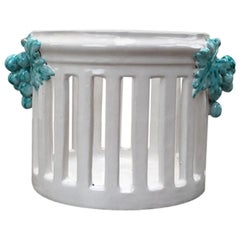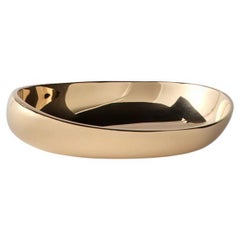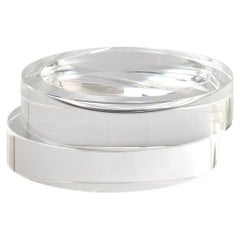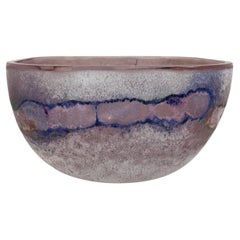Australia - Bowls and Baskets
to
12
50
49
3
10
3
36
53
3
15
16
3
7
8
14
2
38
23
4
3
1
1
32
24
22
13
12
9,504
7,772
43
32
32
24
7
Height
to
Width
to
102
89
91
23
18
8
5
3
Item Ships From: Australia
A Large German Repousse Brass Alms Dish, 17th Century
Located in ARMADALE, VIC
A Large German Repousse Brass Alms Dish, 17th Century
These dishes were originally used as everyday flatware by the wealthy during the Medieval period, serving for food or for holdi...
Category
17th Century German Antique Australia - Bowls and Baskets
Materials
Brass
Zaccagnini Majolica Planter, circa 1950
By Urbano Zaccagnini, Mario Bandini
Located in Melbourne, AU
A handcrafted plant pot holder by the Zaccagnini pottery. This lovely piece is styled as a cylinder of plain white columns under a plain edge, sporting two highly detailed bunches of...
Category
1950s Italian Mid-Century Modern Vintage Australia - Bowls and Baskets
Materials
Terracotta
$236 Sale Price
20% Off
Pietra Brass Dish Unlacquered by Greg Natale
By Greg Natale
Located in Sydney,, NSW
Evoking the organic architecture of Australian coastlines, the Pietra Brass Dish is a delicate design modelled from hand-cast forms. Cast as a high-polished dish, this charming catch...
Category
21st Century and Contemporary Modern Australia - Bowls and Baskets
Materials
Brass
$145 / item
Pila Crystal Bowl Clear by Greg Natale
By Greg Natale
Located in Sydney,, NSW
The Pila Crystal Bowl presents a playful stacked arrangement in reference to the work of modernist architect Paul Rudolph. Reflecting the tension between built and organic forms in c...
Category
21st Century and Contemporary Modern Australia - Bowls and Baskets
Materials
Crystal
$155 / item
Large Signed Alfredo Barbini Scavo Glass Bowl 1970s Blue White and Amethyst
By Alfredo Barbini
Located in Melbourne, AU
Superb large example of Barbini 'Scavo' glass. Amethyst glass with cobalt blue highlights. Wonderful markings, colours and proportions.
Signature to base. One of the largest size...
Category
1970s Italian Brutalist Vintage Australia - Bowls and Baskets
Materials
Art Glass
$1,520 Sale Price
29% Off
Lily Candle Holder Brass Unlacquered by Greg Natale
By Greg Natale
Located in Sydney,, NSW
With softly undulating edges reminiscent of floating lily pads, the Lily Candle Holder brings a sculptural elegance to any surface. Cast as a high-polished dish, the Lily Candle Hold...
Category
21st Century and Contemporary Modern Australia - Bowls and Baskets
Materials
Brass
Pila Crystal Bowl Clear & Black Onyx by Greg Natale
By Greg Natale
Located in Sydney,, NSW
The Pila Crystal Bowl presents a playful stacked arrangement in reference to the work of modernist architect Paul Rudolph. Reflecting the tension between built and organic forms in c...
Category
21st Century and Contemporary Modern Australia - Bowls and Baskets
Materials
Crystal
A Large Glass Punch Bowl
Located in ARMADALE, VIC
A Large Glass Punch Bowl
Provenance: Private Australian Collection.
Dimensions:
Height: 33cm.
Diameter: 40cm.
Category
21st Century and Contemporary Australian Australia - Bowls and Baskets
Materials
Glass
$1,140
A Glass Punch Bowl
Located in ARMADALE, VIC
A Glass Punch Bowl
With a reeded body raised on a facetted foot.
Provenance: Private Australian Collection.
Dimensions:
Height: 23cm.
Diameter: 30cm.
Category
21st Century and Contemporary Australian Australia - Bowls and Baskets
Materials
Glass
Midcentury Murano Glass Bowl in Deep Purple, Italy 1970s
Located in Byron Bay, NSW
This bowl is equally suited as a functional centrepiece or a sculptural decor accent. The intense coloration paired with the subtle transparency of Murano glass makes it ideal for mo...
Category
1970s Italian Mid-Century Modern Vintage Australia - Bowls and Baskets
Materials
Murano Glass
Black Marble Round Ashtray or Empty Pockets by Sergio Asti
Located in Byron Bay, NSW
Elevate your space with the handmade timeless elegance of Carrara Black Marble ashtray. Handcrafted from premium natural marble, this versatile piece features striking white and gold...
Category
1970s Italian Mid-Century Modern Vintage Australia - Bowls and Baskets
Materials
Marble
Black Carrara Marble Ashtray or Empty Pockets by Sergio Asti
Located in Byron Bay, NSW
Crafted from richly veined Carrara Black Marble, this sculptural bowl brings refined sophistication to any surface. With its deep, curved form and polished finish, it's perfect as a ...
Category
1970s Italian Mid-Century Modern Vintage Australia - Bowls and Baskets
Materials
Marble
1950s alabaster Ashtray
Located in LYON, FR
Mother of Pearl ashtray bought in Hawaii in the late 1950's. Since then it has lived in Wollongong Australia. Amazing Lustre. Has a one chip on the botto...
Category
1950s American Organic Modern Vintage Australia - Bowls and Baskets
Materials
Mother-of-Pearl
Murano Glass Centrepiece Bowl
Located in Byron Bay, NSW
This luxury Murano glass bowl is a masterful example of Italian mid-century design. Hand-blown in Murano, Italy during the 1970s, it features an organic freeform silhouette in smoky ...
Category
1970s Italian Mid-Century Modern Vintage Australia - Bowls and Baskets
Materials
Murano Glass
Carter Acrylic Bowl Brushed Platinum Large
By Greg Natale
Located in Sydney,, NSW
Inspired by the mixed metals of the Studio 54 logo, Carter is a bowl to capture the attention of anyone who loves the night life. Hang up your Halston outfit and place your Elsa Pere...
Category
21st Century and Contemporary Unknown Modern Australia - Bowls and Baskets
Materials
Platinum
Round Set of 3 Handmade Baskets by, J'Jute
By J'Jute
Located in Sydney, AU
J'Jute is a luxury all-natural, sustainable brand based in Bondi Beach, Australia. Each piece is designed in Australia and handwoven by skilled artisans in India.
Product Informati...
Category
21st Century and Contemporary Indian Australia - Bowls and Baskets
Materials
Jute
$448 / item
Italian Circular Glazed Ceramic by Rometti, 1978
By Rometti Ceramics 1
Located in Byron Bay, NSW
Italian Rometti round hand painted glazed ceramic.
Rometti is a renowned Italian ceramics company founded in 1927, based in Umbertide, a town in the Umbria region of Italy. The com...
Category
1970s Italian Mid-Century Modern Vintage Australia - Bowls and Baskets
Materials
Ceramic
Italian Ceramic Decorative Dish, 1960s
Located in Byron Bay, NSW
Decorative Italian ceramic dish.
Category
1960s Italian Vintage Australia - Bowls and Baskets
Materials
Ceramic
Limited Edition Rectangular Neutral Beige Travertine Block Tray by Henry Wilson
By Henry Wilson
Located in Geneve, CH
Travertine Block Tray by Henry Wilson
Limited Edition of 50
Dimensions. W 30 x D 18 x H 7 cm
Materials: Classico travertine.
Available in Classico travertine and Persian Brown marbl...
Category
2010s Australian Modern Australia - Bowls and Baskets
Materials
Travertine
Contemporary Blackened Bronze Vide Poche Square by Henry Wilson
By Henry Wilson
Located in Geneve, CH
Blackened Vide Poche Square by Henry Wilson
Dimensions: W 18 x D 18 x H 4 cm
Materials: Bronze
The Vide Poche is designed with your loose-pocket items in mind, think keys, change a...
Category
2010s Australian Modern Australia - Bowls and Baskets
Materials
Bronze
1970s Murano Glass Gasket with Sculptural Handle in Clear textured Finish
Located in Byron Bay, NSW
Perfect as a centerpiece, decorative vessel, or as part of a Murano glass collection, this basket adds a touch of timeless elegance to any space. Its soft organic form and artisan-fi...
Category
1970s Italian Mid-Century Modern Vintage Australia - Bowls and Baskets
Materials
Murano Glass
Travertine Centrepiece Bowl by Fratelli Mannelli
By Fratelli Mannelli
Located in Byron Bay, NSW
Fratelli Mannelli travertine bowl, a timeless piece of mid-century Italian craftsmanship. Hand-carved from natural travertine stone, this bowl showcases its unique porous texture and...
Category
1970s Mid-Century Modern Vintage Australia - Bowls and Baskets
Materials
Travertine
Travertine Centrepiece Bowl by Fratelli Mannelli
By Fratelli Mannelli
Located in Byron Bay, NSW
Fratelli Mannelli travertine bowl, a timeless piece of mid-century Italian craftsmanship. Hand-carved from natural travertine stone, this bowl showcases its unique porous texture and...
Category
1970s Italian Mid-Century Modern Vintage Australia - Bowls and Baskets
Materials
Travertine
Aldo Tura Bowl Italian Made 1950s
By Aldo Tura
Located in Byron Bay, NSW
Aldo Tura hand crafted bowl.
Category
1950s Italian Mid-Century Modern Vintage Australia - Bowls and Baskets
Materials
Wood
$320 Sale Price
20% Off
Contemporary Light Beige Travertine Block Big Poche Rond by Henry Wilson
By Henry Wilson
Located in Geneve, CH
Travertine Block Big Poche Rond by Henry Wilson
Dimensions. W 35 x D 35 x H 7 cm
Materials: Classico travertine.
Available in Classico travertine, Black travertine, and Calacatta ma...
Category
2010s Australian Modern Australia - Bowls and Baskets
Materials
Travertine
Contemporary Coffee Travertine Block Dish with Arched Details by Henry Wilson
By Henry Wilson
Located in Geneve, CH
Black Travertine Block Thoronet Dish by Henry Wilson
Dimensions: W 24 x D 33 x H 6 cm
Materials: Black Travertine
This sculptural item is handmade in...
Category
2010s Australian Modern Australia - Bowls and Baskets
Materials
Marble
Italian Ceramic Dish by Etruria Sesto Fiorentino
Located in Byron Bay, NSW
Italian ceramic hand painted plate by Etruria Sesto Fiorentino 1970s.
Beautiful Decorative centre plate with blue black and red colours.
Category
1970s Italian Mid-Century Modern Vintage Australia - Bowls and Baskets
Materials
Ceramic
$413 Sale Price
24% Off
Rounded-Off Triangle Natural Beige Travertine Dish by Henry Wilson
By Henry Wilson
Located in Geneve, CH
Travertine Thoronet Dish by Henry Wilson
Dimensions: W 20 x D 30 x H 5 cm
Materials: Travertine
This sculptural item is handmade in Sydney Australia.
Thoronet dish, shares its' nam...
Category
2010s Australian Modern Australia - Bowls and Baskets
Materials
Marble
Italian Ceramic Decorative Bowl
Located in Byron Bay, NSW
Italian glazed and painted ceramic decorative bowl 1960s.
Aqua colour and gold painted on top.
Category
1960s Italian Mid-Century Modern Vintage Australia - Bowls and Baskets
Materials
Ceramic
$375 Sale Price
25% Off
Italian Murano Glass Bowl by Archimede Saguso
By Archimede Seguso
Located in Byron Bay, NSW
Italian Mid-Century Modern Murano glass bowl by Archimede Saguso.
Category
1970s Italian Mid-Century Modern Vintage Australia - Bowls and Baskets
Materials
Murano Glass
$1,599 Sale Price
20% Off
Contemporary Silver Aluminum Dish Vide Poche Rond by Henry Wilson
By Henry Wilson
Located in Geneve, CH
Aluminum Vide Poche Rond by Henry Wilson
Dimensions: D 13 x H 4 cm
Materials: Aluminum
Discard your day at the door.
Your Vide Poche is designed with your loose-pocket items in mi...
Category
2010s Australian Modern Australia - Bowls and Baskets
Materials
Aluminum
Decorative Italian Murano Glass Bowl, Basket
Located in Byron Bay, NSW
Decorative handmade Italian Murano Glass bowl-basket beautiful as centrepiece.
Category
1960s Italian Mid-Century Modern Vintage Australia - Bowls and Baskets
Materials
Murano Glass
Mid-Century Modern Italian Ashtray in Black Murano Glass, 1960s
Located in Byron Bay, NSW
Murano ashtray in gray/black glass.
Has a little chip on the bottom but still a beautiful pieces.
Category
1960s Italian Mid-Century Modern Vintage Australia - Bowls and Baskets
Materials
Murano Glass
Contemporary Light Silver Aluminum Dish Vide Poche Rond XL by Henry Wilson
By Henry Wilson
Located in Geneve, CH
Aluminum Vide Poche Rond XL by Henry Wilson
Dimensions: D 18 x 4 cm
Materials: Aluminum
Your Vide Poche is designed with your loose-pocket items in mind – think keys, change and ph...
Category
2010s Australian Modern Australia - Bowls and Baskets
Materials
Bronze
Italian Glass Bowl by Vetri Di Empoli
By Vetro Verde di Empoli
Located in Byron Bay, NSW
Italian green glass bowl by Vetri Di Empoli 1960s.
Category
1960s Italian Mid-Century Modern Vintage Australia - Bowls and Baskets
Materials
Art Glass
$375 Sale Price
25% Off
Three-Dimensional Effect Polished Aluminium Thoronet Dish by Henry Wilson
By Henry Wilson
Located in Geneve, CH
Polished Aluminium Thoronet Dish by Henry Wilson
Dimensions: W 20 x D 5 x H 30 cm
Materials: Aluminium
Thoronet dish, shares its' name and arched lines with the Abby in the south o...
Category
2010s Australian Modern Australia - Bowls and Baskets
Materials
Aluminum
Contemporary White Marble Block Big Poche Rond by Henry Wilson
By Henry Wilson
Located in Geneve, CH
Marble Block Big Poche Rond by Henry Wilson
Dimensions: W 35 x D 35 x H 7 cm
Materials: Marble
This sculptural item is handmade in Sydney Australia.
Each piece is manufactured in n...
Category
2010s Australian Modern Australia - Bowls and Baskets
Materials
Marble
Three-Dimensional Effect Polished Blackened Bronze Thoronet Dish by Henry Wilson
By Henry Wilson
Located in Geneve, CH
Blackened Thoronet Dish by Henry Wilson
Dimensions: W 20 x D 5 x H 30 cm
Materials: Bronze (Blackened)
Thoronet dish, shares its' name and arched lines with the Abby in the south of...
Category
2010s Australian Modern Australia - Bowls and Baskets
Materials
Bronze
Semicircular Top Deep Green Marble Stone Block Dish by Henry Wilson
By Henry Wilson
Located in Geneve, CH
Guatemala Thoronet Dish by Henry Wilson
Dimensions: W 20 x D 30 x H 5 cm
Materials: Guatemala Marble
This sculptural item is handmade in Sydney Australia.
Thoronet dish, shares its...
Category
2010s Australian Modern Australia - Bowls and Baskets
Materials
Marble
Aldo Tura Bowls and Thermos Bottle Italian Made for Cusano
By Aldo Tura
Located in Byron Bay, NSW
Aldo Tura bowl and thermos bottle
Bowl dimensions: 16 H cm 20 D cm
Bottle dimension : 32 H cm 16 D cm.
Category
1950s Mid-Century Modern Vintage Australia - Bowls and Baskets
Materials
Aluminum
$525 Sale Price
25% Off
Dessert Dish, Worcester, circa 1770
By 1st Period Worcester Dr. Wall
Located in Melbourne, Victoria
A dessert dish, in the shape of a shell, and decorated in the Sevres manner.
Category
Late 18th Century English Neoclassical Antique Australia - Bowls and Baskets
Materials
Porcelain
Three-Dimensional Effect Polished Golden Bronze Thoronet Dish by Henry Wilson
By Henry Wilson
Located in Geneve, CH
Polished Bronze Thoronet Dish by Henry Wilson
Dimensions: W 20 x D 5 x H 30 cm
Materials: Bronze
Thoronet dish, shares its' name and arched lines with the Abby in the south of Franc...
Category
2010s Australian Modern Australia - Bowls and Baskets
Materials
Bronze
Recently Viewed
View AllMore Ways To Browse
Ruth Milles
Desimone Hand Painted Art Pottery
Karin Bjorquist
Boda Finland
Fruit Bowl Murano Glass Green Yellow
Hardstone Bowl
Italian Majolica Fruit Basket
Italian Passata Bowls
Jozefina Glass
Krosno Jozefina
Louis Vuitton Bowl
Murano Glass Blue Bowl Star
Robin Welch
Thumbprint Bowl
Tiffany Elsa Peretti Bowls
Virginia Metalcrafters Leaf
Wedgwood Lustre Dragon
Wood Tazza





